Serving 734 students in grades Prekindergarten-4, Park Avenue Elementary School ranks in the bottom 50% of all schools in Massachusetts for overall test scores (math proficiency is bottom 50%, and reading proficiency is bottom 50%).
The percentage of students achieving proficiency in math is 32% (which is lower than the Massachusetts state average of 41%). The percentage of students achieving proficiency in reading/language arts is 25% (which is lower than the Massachusetts state average of 44%).
The student:teacher ratio of 11:1 is lower than the Massachusetts state level of 12:1.
Minority enrollment is 53% of the student body (majority Hispanic), which is higher than the Massachusetts state average of 47% (majority Hispanic).
Quick Stats (2025)
- Grades: Prekindergarten-4
- Enrollment: 734 students
- Student:Teacher Ratio: 11:1
- Minority Enrollment: 53%
- Overall Testing Rank: Bottom 50% in MA
- Math Proficiency: 32% (Btm 50%)
- Reading Proficiency: 25% (Btm 50%)
- Source: National Center for Education Statistics (NCES), MA Dept. of Education
Top Rankings
Park Avenue Elementary School ranks among the top 20% of public schools in Massachusetts for:
Category
Attribute
Diversity
School Overview
Park Avenue Elementary School's student population of 734 students has declined by 8% over five school years.
The teacher population of 65 teachers has grown by 14% over five school years.
Grades Offered
Grades Prekindergarten-4
(offers virtual instruction)
(offers virtual instruction)
Total Students
734 students
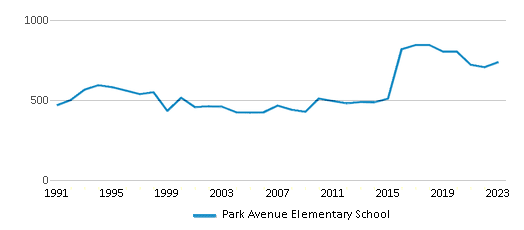
Gender %
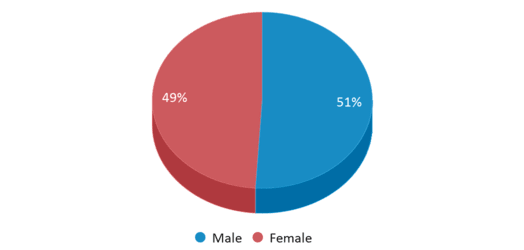
Total Classroom Teachers
65 teachers
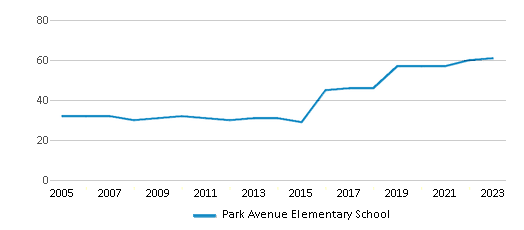
Students by Grade
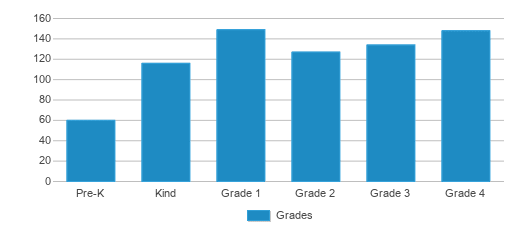
School Rankings
Park Avenue Elementary School ranks within the bottom 50% of all 1,631 schools in Massachusetts (based off of combined math and reading proficiency testing data).
The diversity score of Park Avenue Elementary School is 0.62, which is less than the diversity score at state average of 0.65. The school's diversity has stayed relatively flat over five school years.
Overall Testing Rank
#1204 out of 1631 schools
(Bottom 50%)
(Bottom 50%)
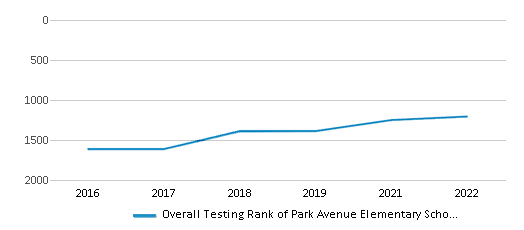
Math Test Scores (% Proficient)
32%
41%
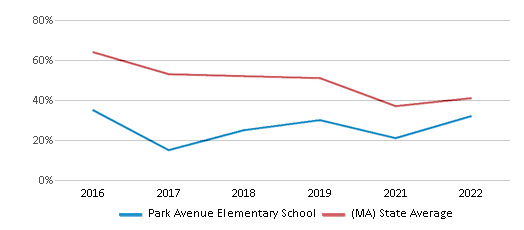
Reading/Language Arts Test Scores (% Proficient)
25%
44%
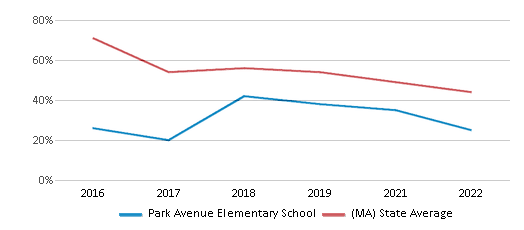
Student : Teacher Ratio
11:1
12:1
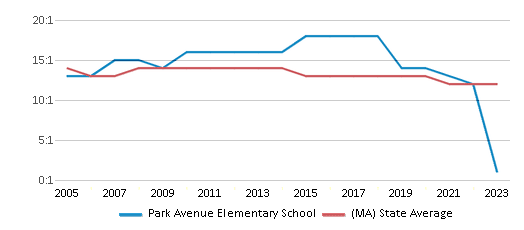
American Indian
n/a
n/a
Asian
1%
7%
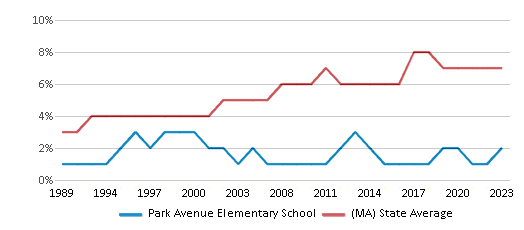
Hispanic
40%
25%
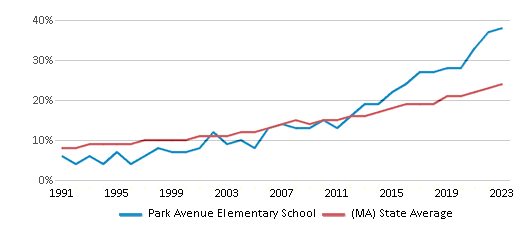
Black
7%
10%

White
47%
53%
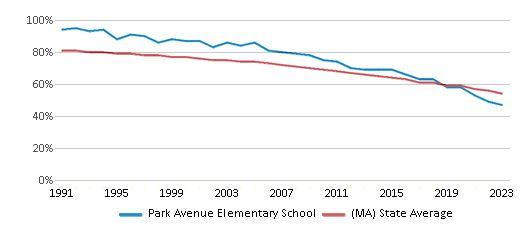
Hawaiian
n/a
n/a
Two or more races
5%
5%
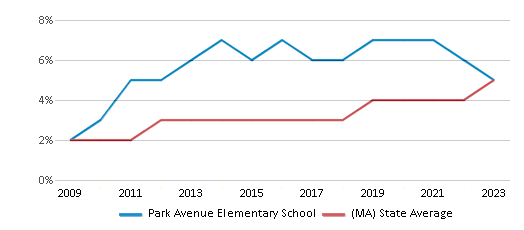
All Ethnic Groups
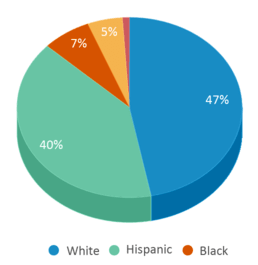
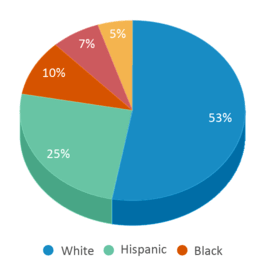
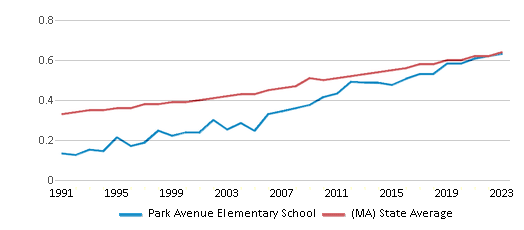
Participates in the National School Lunch Program (NSLP)
Yes
Eligible for Free Lunch
42%
35%
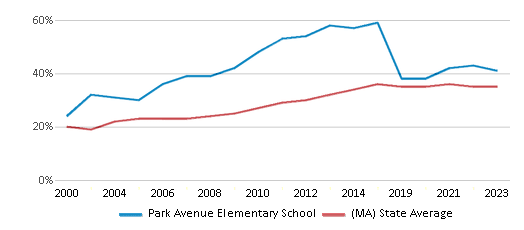
Eligible for Reduced Lunch
3%
4%
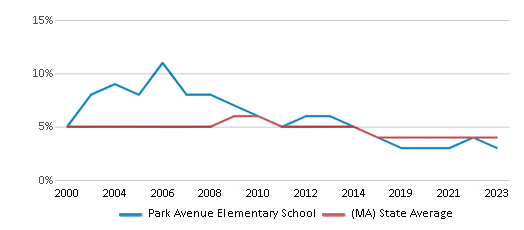
School Statewide Testing
School District Name
Source: National Center for Education Statistics (NCES), MA Dept. of Education
Profile last updated: 02/09/2025
Frequently Asked Questions
What is Park Avenue Elementary School's ranking?
Park Avenue Elementary School is ranked #1204 out of 1,631 schools, which ranks it among the bottom 50% of public schools in Massachusetts.
What schools are Park Avenue Elementary School often compared to?
Park Avenue Elementary Schoolis often viewed alongside schools like Charles S Ashley by visitors of our site.
What percent of students have achieved state testing proficiency in math and reading?
32% of students have achieved math proficiency (compared to the 41% MA state average), while 25% of students have achieved reading proficiency (compared to the 44% MA state average).
How many students attend Park Avenue Elementary School?
734 students attend Park Avenue Elementary School.
What is the racial composition of the student body?
47% of Park Avenue Elementary School students are White, 40% of students are Hispanic, 7% of students are Black, 5% of students are Two or more races, and 1% of students are Asian.
What is the student:teacher ratio of Park Avenue Elementary School?
Park Avenue Elementary School has a student ration of 11:1, which is lower than the Massachusetts state average of 12:1.
What grades does Park Avenue Elementary School offer ?
Park Avenue Elementary School offers enrollment in grades Prekindergarten-4 (offers virtual instruction).
What school district is Park Avenue Elementary School part of?
Park Avenue Elementary School is part of Webster School District.
School Reviews
1 3/23/2019
My advise run for the hills. Walk the extra mile and put your child in another school. This school is no good. The education structure is poor, there is no maintained order amongst teachers and staff. The end result your child will be given poor education.
2 2/24/2016
The most disorganized school ever! Lack of communication for sure! Everything is done last minute, not a school I would recommend. They need to do better in all areas.
2 7/17/2015
Park ave elementary lacks communication, educational structure, and organization. Has had terrible communication for two years. I would never allow my son to go to this school again.
Review Park Avenue Elementary School. Reviews should be a few sentences in length. Please include any comments on:
- Quality of academic programs, teachers, and facilities
- Availability of music, art, sports and other extracurricular activities
Recent Articles

What Is A Charter School?
Explore the world of charter schools in this comprehensive guide. Learn about their history, how they operate, and the pros and cons of this educational innovation. Discover key facts about charter schools, including admission policies, demographics, and funding, as well as what to look for when considering a charter school for your child.

10 Reasons Why High School Sports Benefit Students
Discover the 10 compelling reasons why high school sports are beneficial for students. This comprehensive article explores how athletics enhance academic performance, foster personal growth, and develop crucial life skills. From improved fitness and time management to leadership development and community representation, learn why participating in high school sports can be a game-changer for students' overall success and well-being.

February 05, 2025
Understanding the U.S. Department of Education: Structure, Impact, and EvolutionWe explore how the Department of Education shapes American education, from its cabinet-level leadership to its impact on millions of students, written for general audiences seeking clarity on this vital institution.





